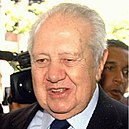Portuguese presidential election, 2006
|
|
|||||||||||||||||||||||||||||||||||||||||||||
|---|---|---|---|---|---|---|---|---|---|---|---|---|---|---|---|---|---|---|---|---|---|---|---|---|---|---|---|---|---|---|---|---|---|---|---|---|---|---|---|---|---|---|---|---|---|
|
|||||||||||||||||||||||||||||||||||||||||||||
| Turnout | 61,53% | ||||||||||||||||||||||||||||||||||||||||||||
|
|||||||||||||||||||||||||||||||||||||||||||||
|
|||||||||||||||||||||||||||||||||||||||||||||
The Portuguese presidential election were held on 22 January 2006 to elect a successor to the incumbent President Jorge Sampaio, who was term-limited from running for a third consecutive term by the Constitution of Portugal. The result was a victory in the first round for Aníbal Cavaco Silva of the Social Democratic Party candidate, the former Prime Minister, won 50.54 percent of the vote in the first round, just over the majority required to avoid a runoff election. Voter turnout was 61.53 percent for eligible voters.
Any Portuguese citizen over 35 years old has the opportunity to run for president. In order to do so it is necessary to gather between 7500 and 15000 signatures and submit them to the Portuguese Constitutional Court.
According to the Portuguese Constitution, to be elected, a candidate needs a majority of votes. If no candidate gets this majority there will take place a second round between the two most voted candidates.
In the presidential election of 14 January 2001, the outgoing Socialist Jorge Sampaio was re-elected in the first round with 55% of votes. Because he was term-limited, he was forbidden, by the Constitution, to run for a third consecutive term.
In the parliamentary elections of 20 February 2005, the Socialist Party, led by José Sócrates, won for the first time in its history an absolute majority of seats, while the Social Democratic Party led by Prime Minister Pedro Santana Lopes fell below 30%, their worst result since 1983.
...
Wikipedia





